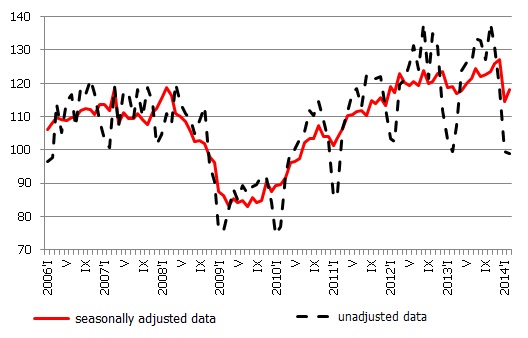January drop revised substantially; a month-on-month growth in February
According to Central Statistical Bureau (CSB), manufacturing output in February grew 3.3% month-on-month according to seasonally adjusted data. The year-on-year output in February dropped by 0.6% (working day adjusted data).
The January plunge in manufacturing was adjusted from minus 17.3% to minus 9.9% month-on-month and from minus 11.3% to minus 3.5% year-on-year. The revision of January data was expected because, as we already noted previously, last month's reading was that disappointing due to both, fundamental problems in manufacturing as well as statistical nuances. In the latest data, the CSB has revised the weights structure of the value added in order to better judge the impact of metal production branch on manufacturing at large.
The month-on-month growth of manufacturing in February was fostered by rapid growth in the production of metals and beverages, the branches that posted the sharpest drop in output in January. Here we must also remember that even a slight increase in the output of metal production will result in a rapid growth percentage-wise, since the output index of the branch has shrunk to a negligible size. Output growth was observed also in the large branches of manufacturing: wood-processing (+3.3%) and food industry (+2.2%).
Year-on-year, the most substantial growth was observed in the manufacturing of computers, electronic, and optical equipment as well as the largest branches: the production of foodstuffs and wood products. The output of non-metallic mineral products branch increased both month-on-month and year-on-year, posting the highest level since mid-2008. That points to a rise in construction activity, possibly in part owing to the favourable weather conditions last winter. Indeed, the European Commission survey on construction business sentiment indicates that whereas in March of last year 38% of the respondents pointed to weather conditions as a factor limiting the building activity, in March 2014 only 16% considered weather conditions as an obstacle to business growth.
Sentiment indicators in manufacturing and Latvia's overall ESI (Economic Sentiment Indicator) dropped in March, which may be related in part to the escalation of the conflict between Russia and Ukraine and its impact on the outlook on business environment and confidence. Speaking of our trade partners, the Russian manufacturing PMI[1] (Purchasing Managers Index) indicators were below the 50 point mark for the fifth consecutive month, and services PMI also pointed to a decline in activity. Even though the drop in Russian demand is a serious problem for our manufacturers, especially in certain branches, the economic situation in the European Union – an even more important export market of ours – is gradually improving. The manufacturing PMI in Germany and Poland continues to signal growth in the sector, whilst the French manufacturing PMI, after a prolonged spell of weakness, finally rose above the 50-point mark in March. Surveys on the construction market development in Germany and the United Kingdom also continue to point to growth. The positive signals from Europe give rise to hope that, barring a further deterioration of the Russia-Ukraine crisis, the negative impact from the downward slide in Russian demand may be partially compensated.
Illustration. Volume index of manufacturing production (2010=100), seasonally adjusted and unadjusted data

[1] PMI (Purchasing Manager's Index) is an indicator based on business surveys, reflecting the existing economic situation. PMI indicator under 50 points to dropping activity and above 50 to growing activity, 50 indicates a neutral situation.
Textual error
«… …»




